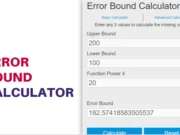Kilograms to Grams Calculator
What is a Kilograms to Grams Calculator Website?
A Kilograms to Grams Calculator website is an online tool designed to help users easily convert a mass from kilograms to grams. By inputting a value in kilograms, the calculator instantly provides the equivalent value in grams using the formula: 1 kilogram = 1000 grams. This tool is ideal for quick conversions, making it valuable for students, researchers, and professionals who need accurate measurements without manual calculations.
What is Kilograms to Grams?
Kilograms and grams are both units of mass in the metric system. One kilogram is equal to one thousand grams, making the conversion simple: to convert kilograms to grams, multiply the number of kilograms by 1000. This relationship is fundamental in the metric system, which is widely used around the world for scientific, educational, and commercial purposes. Converting kilograms to grams is useful in various situations, especially when dealing with smaller quantities or requiring precision in measurements.
How to Use the Kilograms to Grams Calculator Website
To use the Kilograms to Grams Calculator website, enter the mass in kilograms into the input box provided. Once the value is entered, click the "Calculate" button to perform the conversion. The result will be displayed in grams below the input box, along with a detailed explanation of the calculation process. If you want to perform another conversion, click the "Clear" button to reset the input field and start again.
Frequently Asked Questions
1. What is a kilogram?
A kilogram (kg) is a unit of mass in the metric system. It is equal to one thousand grams.
2. What is a gram?
A gram (g) is a unit of mass in the metric system. It is equal to one-thousandth of a kilogram.
3. How do I convert kilograms to grams?
To convert kilograms to grams, multiply the mass in kilograms by 1000.
4. Why use a kilograms to grams calculator?
A calculator simplifies the conversion process and reduces the chance of errors.
5. Can I convert grams to kilograms?
Yes, to convert grams to kilograms, divide the mass in grams by 1000.
6. Is the conversion between kilograms and grams accurate?
Yes, the conversion is based on the standard metric conversion factor.
7. How many grams are there in a kilogram?
There are 1000 grams in a kilogram.
8. Can this calculator be used for any weight conversion?
This calculator is specifically designed for converting kilograms to grams.
9. Is the conversion process affected by the type of material?
No, the conversion factor between kilograms and grams is constant regardless of material.
10. Is the calculator free to use?
Yes, this kilograms to grams calculator is free to use.
11. Do I need to install any software to use this calculator?
No, you can use this calculator directly on this webpage without any installations.
12. Can I use this calculator on my phone?
Yes, the calculator is mobile-friendly and can be used on any device with a web browser.
Related Calculator-









